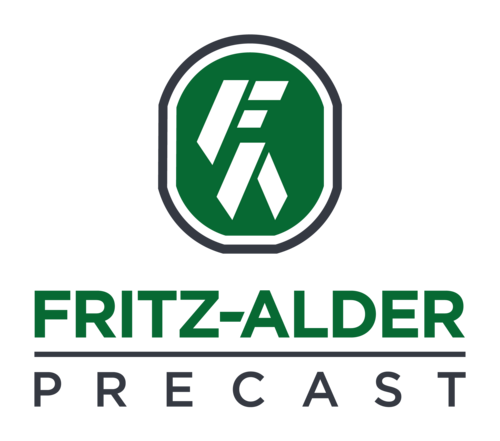
We collect basic website visitor information on this website and store it in cookies. We also utilize Google Analytics to track page view information to assist us in improving our website.

At Fritz-Alder Precast, we’re proud to be leading the way in hollowcore slab manufacturing, with the widest variety of hollowcore sizes and spans you'll find anywhere.
But we're not stopping there. We're always looking for ways to make our slabs even better.
In this blog post, we talk about technologies that are changing the way we make hollowcore slabs and how these advancements are making construction faster, greener, and more efficient.
Hollowcore precast slabs have been around since the early 1900s, gaining popularity towards the second half of the 20th century. They were born out of a simple idea: how can we make concrete slabs lighter and less expensive without making them weaker?
The solution was creating hollow spaces inside the slabs to significantly reduce the amount of concrete needed, making the slabs lighter and easier to handle. This also meant less strain on the building's structure and lower transportation costs.
Hollowcore slabs also offered:
Smaller structural load: Lighter slabs meant less stress on the building's foundation and supporting structures.
Better insulation: Those air pockets acted like tiny insulators, helping to keep buildings warmer in the winter and cooler in the summer.
Faster construction: With lighter slabs, installation became quicker and easier, saving time and money.
And let's not forget about speed. Hollowcore slabs are precast in a factory, which means they're ready to go as soon as they arrive on site. This can significantly speed up construction time, saving everyone time and money.
It's no wonder that hollowcore slabs quickly caught on and became a popular choice for all sorts of buildings, from homes and offices to schools and hospitals. And as technology has advanced, so too has the production of hollowcore slabs, leading to even more impressive benefits - but we'll get to that later.
As with any innovation, the production of hollowcore slabs has evolved significantly since its beginnings some hundred plus years ago.
Modern “wet casting” began as early as 1906. This involved pouring a wet concrete mixture into a mold that already had the hollow spaces incorporated. The concrete would then cure within the mold, taking on the desired shape.
Another early technique, "slip forming," was patented in 1933. This method utilized a machine that continuously extruded concrete into a moving mold, creating a long, uninterrupted slab with pre-formed hollow cores.
Later in the 1960s, the "vibratory extrusion process" emerged. This technique involved using a machine equipped with auger screws to push concrete into a mold. Simultaneously, the machine would vibrate at a high frequency, compacting the concrete and ensuring a dense and uniform structure.
These early methods were pioneering, but they had their limitations. Quality control could be challenging, with inconsistencies in the finished product. Plus, the vibratory extrusion process generated significant noise pollution, and the machinery required frequent maintenance, leading to downtime.
Despite these challenges, these early production methods played a vital role in establishing hollowcore slabs as a viable construction material. They laid the foundation for the remarkable advancements we see in modern hollowcore production today.
Early hollowcore slabs, while innovative, relied primarily on conventional steel reinforcement for strength. However, the introduction of prestressing in the 1950s revolutionized their structural capabilities.
Prestressed concrete involves applying a compressive force to the concrete before it's subjected to the loads it will carry in a building. This is typically achieved by embedding high-strength steel tendons within the concrete and then tensioning them, like pulling on a bowstring. Once the concrete hardens, the tensioned tendons exert a continuous compressive force, counteracting the tensile stresses that occur under load.
This ingenious technique significantly improved the performance of hollowcore slabs. It allowed for longer spans between supports, increased their load-bearing capacity, and reduced the likelihood of cracking.
Prestressing makes hollowcore slabs stronger, more efficient, and more durable. This is what really paved the way for a wide variety of hollowcore applications: from residential and commercial buildings to large-span structures like stadiums and parking garages.
Like the introduction of prestressing, shear compaction arrived, in 1984, as another game-changer in hollowcore production.
Shear compaction extruders, like their vibrating counterparts, use auger screws to shape and compact concrete. However, instead of relying solely on vibration, they harness the power of shear forces.
As the augers rotate and push the concrete forward, they also generate a shearing action within the mix. This intense shearing force effectively compacts the concrete, resulting in a denser and more homogenous structure.
Shear compaction offers a range of improvements over vibratory extrusion, including:
Reduced Noise: This creates a better working environment and reduces disruption to surrounding areas.
Enhanced Strength and Durability: The shearing action produces slabs with exceptional strength and durability, capable of withstanding heavy loads and resisting cracking.
Improved Consistency: Shear compaction leads to greater uniformity in the concrete mix, ensuring consistent quality across every slab.
Faster Production: The efficiency of shear compaction can lead to faster production cycles, enabling precasters to meet tight project deadlines.
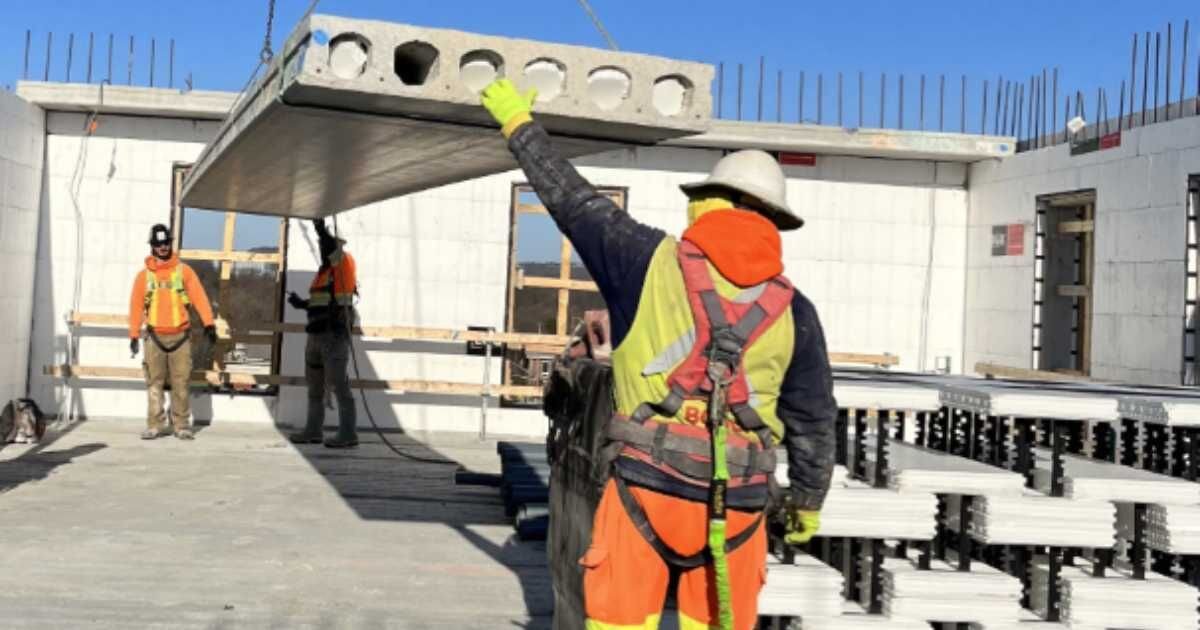
At Fritz-Alder Precast, we've always embraced innovation. That's why we were the first company in Ontario to adopt shear compaction technology. We recognized its potential to enhance the quality, efficiency, and sustainability of our hollowcore slab production.
One of the key advantages we've found with shear compaction is its ability to prevent differential camber. Camber refers to the slight upward curve intentionally built into slabs to counteract deflection under load. Differential camber occurs when different sections of a slab have varying degrees of curvature, leading to potential installation and structural issues.
Shear compaction's controlled, three-dimensional vibration at a precise frequency ensures a uniform and consistent slab, minimizing the risk of differential camber and delivering a superior product to our clients.
Shear compaction and prestressing represented a major leap forward in hollowcore production. So, where do we go from here?
Today, there are a range of cutting-edge technologies that are improving the way we design, manufacture, and track precast slabs, including digital tools, innovative mixes, and RFID tracking technology. Here’s how they’re making an impact.
One of the biggest developments is the use of 3D modeling and Building Information Modeling (BIM) in precasting. If you're not familiar, think of BIM as a detailed digital blueprint for a building that contains a wealth of information about every single component, including our hollowcore slabs.
3D models and BIM make it easier to visualize and refine designs, ensuring the slabs fit perfectly into the overall structure. We can take the BIM data and use it to generate precise shop drawings.
BIM also helps streamline coordination between the various trades that all play an important role on a construction site. Everyone has access to the same up-to-date information, reducing conflicts and delays. Plus, the precise dimensions and placement of the slabs in the BIM model help ensure a smooth and efficient installation process.
In a nutshell, 3D modeling, and BIM take a lot of the guesswork and phone tag out of construction.
One of the most exciting developments is self-compacting concrete (SCC). It's like the self-parking cars of the concrete world. SCC flows easily into every nook and cranny of the mold, filling it completely without needing any extra vibration or compaction. This not only simplifies the production process but also results in a smoother, more aesthetically pleasing finish on the slabs.
Another innovation is fiber-reinforced concrete (FRC). Think of it like adding tiny steel hairs to the concrete mix. These fibers increase the concrete's tensile strength (its ability to resist pulling forces), making the slabs even more durable and less prone to cracking. This can also mean using less traditional steel reinforcement, which saves on both cost and environmental impact.
They are helping to create hollowcore slabs that are not only stronger and more durable but also more sustainable and easier to produce.
Have you ever wondered how packages get tracked so efficiently as they travel across the globe? Well, a similar technology is now being used to track precast products, including hollowcore slabs.
Radio Frequency Identification (RFID) tags, tiny computer chips that can store and transmit information, can be embedded directly into the slabs during production. These tags contain important information like the slab's production date, the materials used, and any other relevant details.
If there's ever an issue with a slab, the RFID tag can provide valuable information about its production history, making it easier to identify and address any potential problems.
Even years down the line, if a building needs repairs, the RFID tags can tell workers exactly what type of slab they're dealing with, making maintenance and upgrades a whole lot simpler. It brings a new level of transparency and efficiency to the construction process.
Today's prestressed and reinforced hollowcore floor slabs are a far cry from their early predecessors. They are the result of decades of research, development, and tireless innovation.
But the journey isn't over. As we've seen, the production methods are evolving at a faster pace than ever. At Fritz-Alder Precast, we're excited to be part of this ongoing evolution.
Contact us today to learn more about our hollowcore solutions and how we can help you build smarter, faster, and more sustainably.
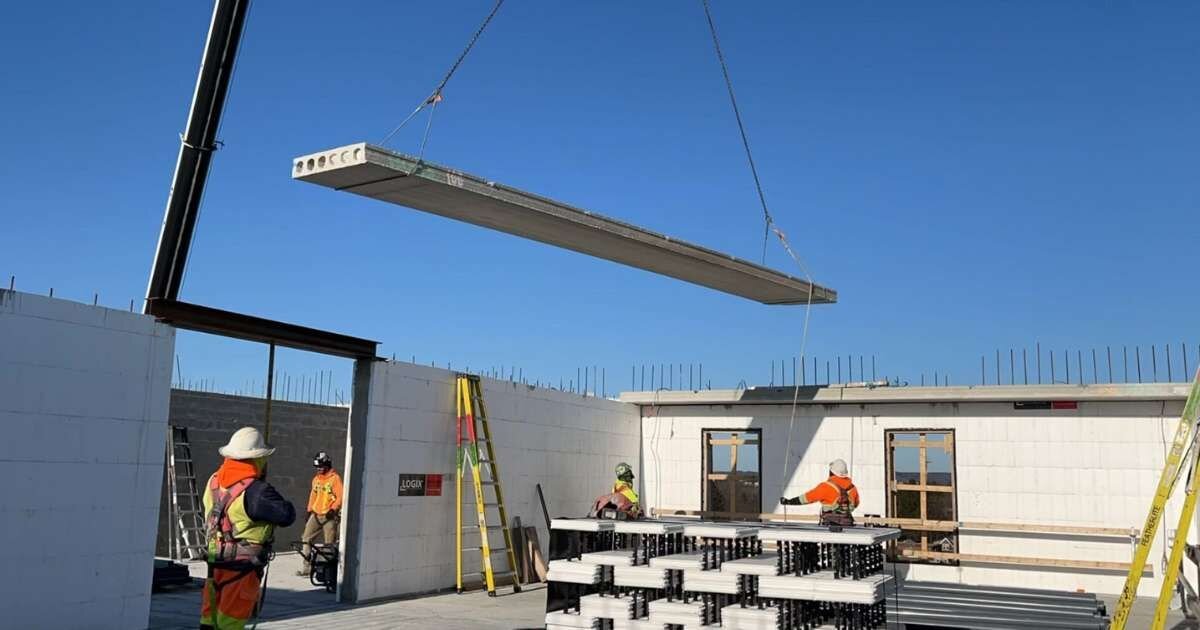
Let's face it: large-scale construction projects have many moving pieces and can prove to be challenging at times.
The ticking clock of tight deadlines and the puzzle of translating complex designs into reality is enough to challenge even the most seasoned pros.
These situations are all too common in the construction industry, but here's the good news: there's a solution that can address these issues and help you build better, faster, and more sustainably. That solution is precast concrete.
Grab a cup of coffee, because we're diving into seven common construction challenges and showing you how precast concrete can be the solution you've been searching for.
Every construction project comes with a schedule, and that schedule often feels ambitious.
The usual issues like delayed deliveries, surprise storms, or labour shortages are common, and they have a way of impacting project timelines.
You know the feeling. We've all been there. You're carefully reviewing that project timeline, adjusting resources and strategizing to stay on track.
And you're not alone in this. McKinsey tells us that large-scale projects typically take 20% longer than planned. Another study by KPMG found that only 25% of projects come within 10% of their original deadlines.
With precast concrete, your floor slabs and walls show up on time, every time.
Built in a climate-controlled factory (where even the weather is on your side!), precast components sidestep those unforeseen delays that usually impact job sites. Rain or shine, your project keeps cruising along.
Precast's predictable timelines take the guesswork out of scheduling. And if life happens and you need to adjust that delivery date, we’ve got plenty of storage space around here, so your precast pieces stay safe and sound.
The phone rings. It's another call from a subcontractor, and it's not good news – they’re short-staffed.
Unfortunately, in the construction world, finding and keeping skilled workers is becoming more challenging.
Tasks take longer and your project timeline shifts. When you're working hard to finish with a smaller crew, quality can be affected.
Worse, less experience on the job can mean more safety concerns.
Picture this: a tractor-trailer pulls up to your site, not just with a load of concrete, but with your precast walls ready to become part of your building. A small team of crane operating pros swoops in and makes those walls part of your structure faster than you can say "efficiency."
That's the magic of precast.
Precast products arrive partially or fully finished, which means less work for your crew on-site. By letting the precast manufacturer handle most of the heavy lifting (literally), you streamline your project, maintain top-notch quality, and create a safer environment for everyone.
Ever seen an architect's drawings and wondered, "How are we going to bring this to life?"
Fancy curves, detailed finishes, and complex geometries can look amazing on paper, but translating them into reality on-site is often more involved.
Turning complex shapes from 2D blueprints into 3D structures is a puzzle that doesn't always fit together perfectly. Sometimes, the architect's vision might present challenges for traditional building materials. What seems totally feasible in a cozy studio might require careful consideration on the construction site.
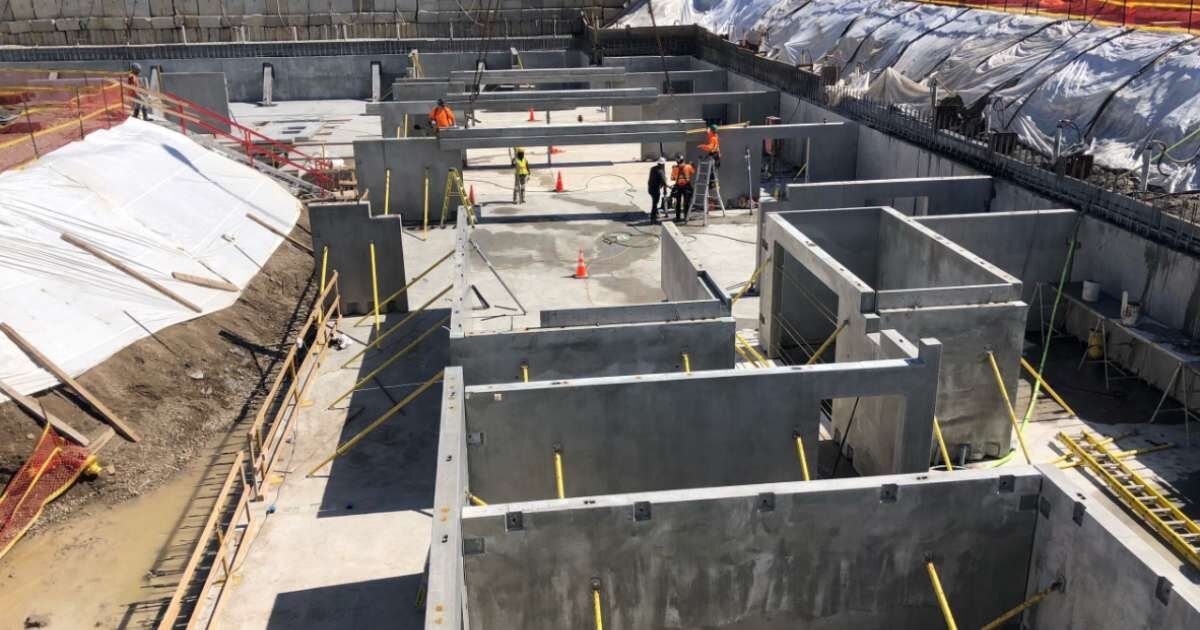
With precast concrete, your custom-designed elements roll up to your site, ready to fit seamlessly into your project like a Lego masterpiece.
Using custom-built forms, precast manufacturers can precisely replicate even the most intricate designs with a level of precision only possible in a controlled factory environment.
Precast concrete transforms that complex design puzzle into a smooth, satisfying process.
In construction, safety is the name of the game. Keeping a site safe is a 24/7 responsibility. There are the daily safety briefings, the endless paperwork, and the hope that your efforts are enough to keep everything running smoothly.
Think about it: the more work that's done off-site, the fewer workers are exposed to the complexities of a construction site. That's another advantage of precast.
Manufactured in a controlled factory setting, precast components significantly reduce the amount of work that needs to be done on-site.
By moving a big chunk of the construction process to this safer, more predictable setting, precast lets you sleep a little better at night.
Construction sites aren't always the most eco-friendly. The dumpster bins, the muddy terrain, and the constant road of earth-moving engines can prompt you to reflect on the environmental impact of your project. Especially knowing that the construction industry is responsible for a lot of air and water pollution, as well as landfill waste.
You want to do the right thing, but it's a balancing act between building fast and cost-effectively, and being sustainable.
Precast offers a more sustainable way to build. It starts with being smart about materials, using only what's needed and minimizing waste during production.
But the eco-benefits don't stop there. Precast structures are built to last, so they need less upkeep and won't need replacing as often. It's like buying a high-quality pair of boots – sure, they cost a bit more upfront, but they'll save you money (and landfill space) in the long run.
Less maintenance means fewer resources used over time – it's a win-win for your project and the environment
Sometimes, a project’s budget can go off course. Unexpected expenses arise suddenly, turning your budget meetings into focused discussions on "Where can we spend less?" It's a juggling act between keeping costs down and quality up.
These aren't just numbers on a spreadsheet, they're the heart of project management decisions. They can lead to delays, disagreements, and in extreme cases, significantly impact the project.
With precast concrete, you get upfront, transparent pricing – no surprises, no hidden fees, no stress. You know exactly what you're spending, making it way easier to manage your resources and avoid those dreaded cost overruns that keep you up at night.
Precast concrete transforms budget management from a challenge into a breeze. It's a solution that lets you focus on building your project, not reviewing your spreadsheet.
Ever feel like you're playing a real-life game of Tetris on your construction site? Limited space is a common challenge, especially in urban areas or projects with tight footprints. When you're constantly juggling material deliveries, equipment maneuvering, and worker movement, it's easy for things to get crowded.
These logistical complexities can have real consequences. A congested site slows everything down and can pose more safety concerns.
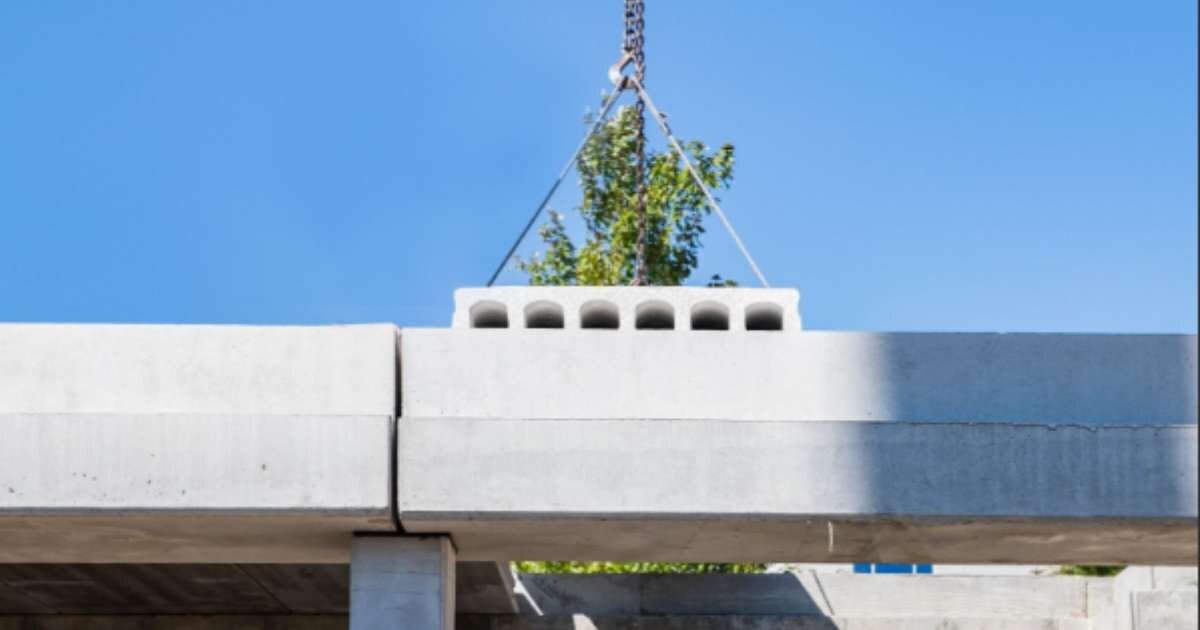
With precast, your components arrive just when you need them. No need for massive storage areas filled with materials.
Your precast pieces are ready to be installed right off the truck, freeing up precious space and making your site less cluttered.
Tight timelines, labour shortages, complex designs, safety concerns, environmental impact, budget constraints, and limited site space can all add up to a challenge for even the most seasoned construction professional.
But it doesn't have to be that way.
For construction and project managers, precast concrete is more than just a building material, although it is an incredible one. It's also a strategic tool that can streamline your projects, ease pressure, and improve your bottom line.
If you're ready to explore new solutions, it's time to consider precast concrete for your next project. Contact a Fritz-Alder Precast today to learn more about how precast can help you build better, faster, and more sustainably.

When you think of structures that stand the test of time, what comes to mind?
How about the Pantheon in Rome, with its massive concrete dome that has stood tall for nearly two thousand years?
Or the Roman Colosseum, which has withstood centuries of combat and unruly crowds (both ancient and modern)?
Even the ancient Roman aqueducts (at least one of which still carries water today) still exist, in large part, thanks to the awesome longevity of concrete.
Of course, concrete isn't just a relic of the past. Here at home, iconic structures like the CN Tower – built with a mind-blowing 40,538 cubic meters of concrete – prove that concrete is in it for the long haul.
Concrete is an incredibly versatile building material. While the ancients certainly knew a thing or two about concrete, modern technology allows us to create concrete that is even stronger and more durable.
Fritz-Alder Precast is at the forefront of precast concrete. Get in touch with our team to discuss your project requirements.
The secret to concrete’s strength and longevity comes down to basic chemistry.
When cement powder and water mix, a chemical reaction called hydration occurs, which transforms the mixture into a rock-like substance. Unlike natural rock, which forms through unpredictable geological processes, concrete is created in a controlled environment. This allows engineers to meticulously select and proportion ingredients like cement, water, and aggregates to achieve specific performance characteristics.
The result is a material that is not only strong and durable but also predictable and consistent in its behaviour.
Plus, concrete's unique chemical composition (primarily calcium silicate hydrates) gives it exceptional compressive strength and resilience against the elements. Even in damp or salty conditions, it stands strong.
So, while hardened concrete may resemble rock in appearance and strength, it's actually even better.
And unlike other building materials – wood, steel, and many engineered building products – concrete won’t ever rot, rust, or burn. This natural resistance to all sorts of elements is a big part of why concrete structures can last for generations.
It's also incredibly versatile. Engineers and builders have a high degree of control over its properties through adjustments to the mix design, such as such as high-strength concrete for skyscrapers, fiber-reinforced concrete for crack resistance, self-consolidating concrete for complex forms, or admixtures that speed or slow curing time.
This flexibility goes even further with reinforcement. Adding steel bars, mesh, or wire tendons creates a super-material that takes the best of both worlds: the strength of concrete under pressure, and the flexibility of steel under tension.
All this to say, concrete isn't just strong and versatile, it's inherently durable.
Concrete structures truly do stand the test of time – whether you measure that in years, decades, or centuries.
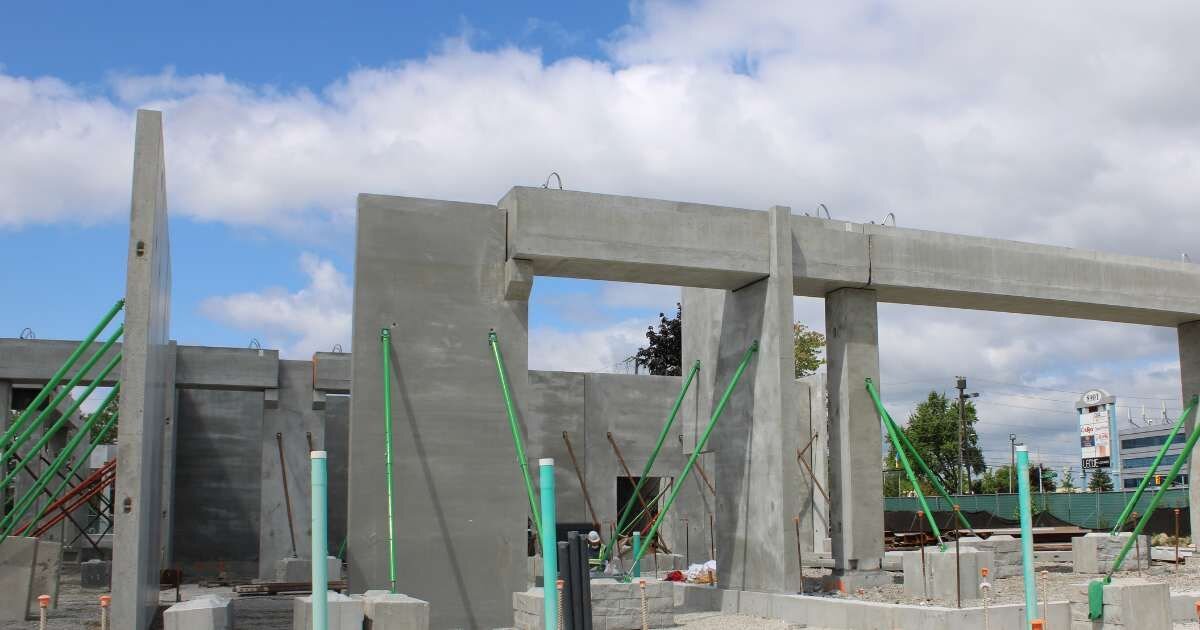
As we've seen, people have been building incredible structures with concrete for thousands of years. But with all due respect to the Romans, modern technology allows us to take full advantage of concrete’s inherent qualities.
Precast concrete takes all the good things about concrete – the strength, the durability, the versatility – and ramps them up through a controlled manufacturing process.
Precast concrete manufacturing occurs in a controlled, indoor environment that helps every batch of concrete cure evenly and predictably, resulting in a stronger and more durable product.
Consistent temperature and humidity create the ideal conditions for hydration (the chemical process we touched on earlier).
Precast products cure in a climate-controlled space where the temperature is just right, reducing the chance of any problems related to fluctuating temperatures or weather conditions.
You can be confident that the final product is not only uniform and attractive but also strong and reliable.
In the world of concrete, the ratio of water-to-cement (w/c) is a key ingredient in its long-term strength. Too much water and your concrete mix becomes weak and porous, while too little makes it difficult to work with. Some precast concrete products require a higher or lower w/c ratio for specific applications.
Precast concrete production allows for precise control over this ratio to create concrete that's both strong and easy to use. automated systems to measure out the exact amounts of water and cement needed. This precision, along with the controlled indoor environment, means they can use less water overall.
This might seem like a small detail, but it makes a big difference. Less water leads to a denser concrete mix, which is naturally stronger and better able to handle heavy loads.
Quality control is the backbone of precast concrete manufacturing. In a precast concrete plant, every step of the process, from the raw materials to the final curing stage, is subject to quality control measures.
Before any concrete is mixed, the raw materials – cement, aggregates, water, and admixtures – undergo checks for moisture content, gradation, chemical composition, etc.
The proportions of each ingredient in the concrete mix are carefully calculated the right strength and properties for the job.
Throughout production, samples of fresh concrete are tested for workability, air content, and other properties.
Once the concrete has cured, finished precast elements are inspected for imperfections.
Detailed records are kept of all quality control activities, including test results, material sources, and production parameters. If any problems ever come up, we can quickly trace them back to the source and fix them.
Precast concrete manufacturers invest in specialized teams and advanced technology to achieve the highest level of quality control. These experts understand the science behind concrete, from the ideal mix design to the best curing methods, resulting in a superior and reliable product.
When you choose precast concrete, you can be confident that you're getting a reliable product that won't require costly repairs or cause delays in your project schedule. This translates to a more efficient construction process and lower maintenance costs over the lifespan of your building.
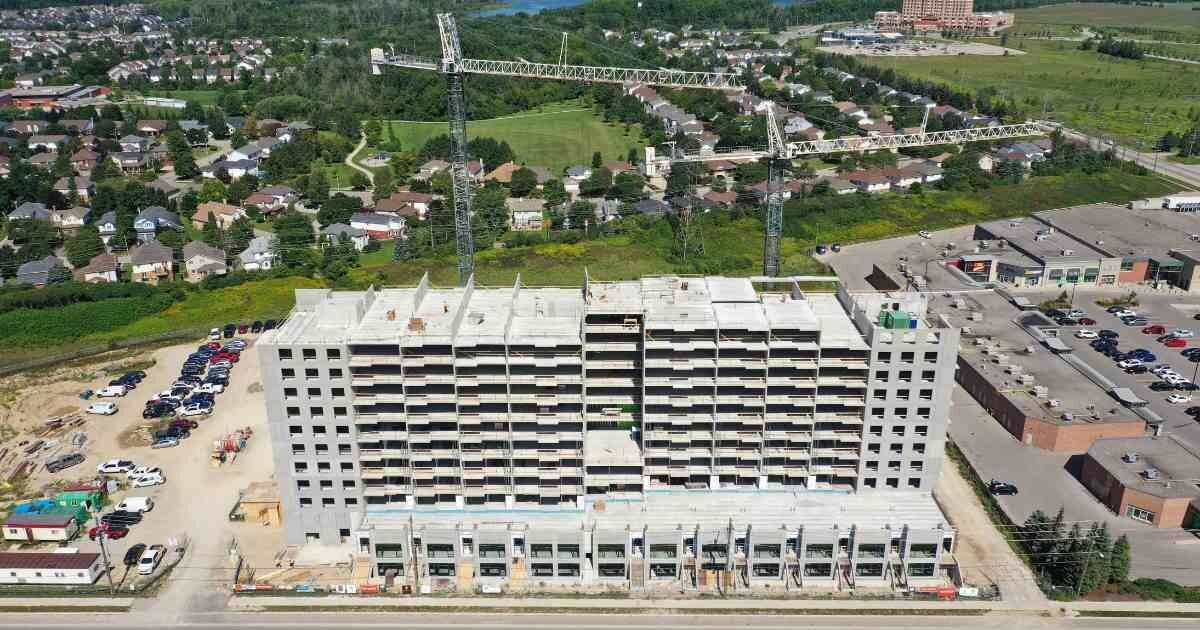
Precast concrete is a triple threat: it's strong, long-lasting, and saves you money. But that's not all. It's also a sustainable choice, as the controlled production process minimizes waste. And since it's built to last, you won't need to repair or replace it as often.
Precast concrete offers a range of long-term benefits. Its exceptional durability translates to lower maintenance costs over time.
Precast concrete's durability stems from meticulous quality control in factory settings, ensuring precise mixtures and curing conditions. Precast components offer enduring strength and reliability in construction due to their ability to resist weathering, seismic activity, and wear over time. By reinforcing structures against corrosion and cracking, they provide exceptional performance.
Plus, the efficiency of precast construction can significantly shorten project timelines, saving you valuable time and money.
In fact, for many projects, precast concrete ends up being a cost-effective option overall.
While you’re probably not looking to build the next Colosseum (although maybe you are – who knows?), at Fritz-Alder Precast, we're ready to help you build something that will last. Our specialties include hollowcore slabs, perfect for floors and roofs in multi-story buildings, and precast wall panels that combine strength and efficiency.
Ready to see the precast difference firsthand? Contact Fritz-Alder Precast today to discover how precast concrete can transform your next project. With our unwavering dedication to quality, innovation, and sustainability, we're confident that precast concrete will exceed your expectations and provide enduring value for years to come.
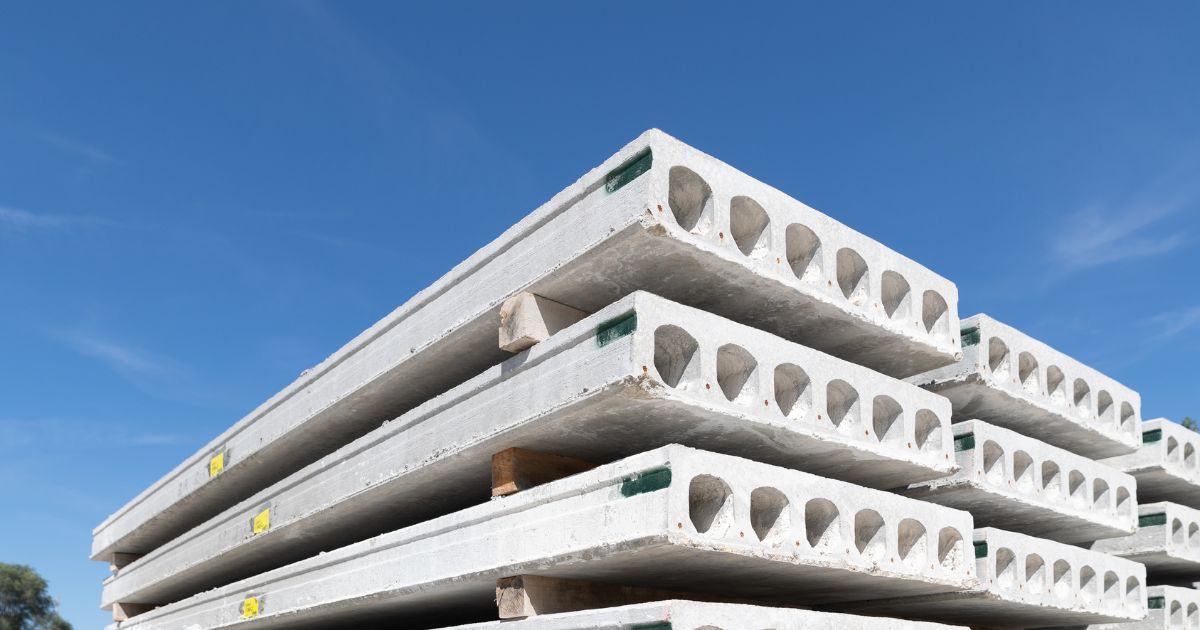
Precast plants are hard to miss.
From the outside, it can look a bit like a concrete jungle. Ever wondered what happens behind the scenes?
If you're curious about the inner workings of precast concrete, you're in the right place. Let’s go on a bit of a behind-the-scenes tour and look at the process of precast concrete manufacturing—the gritty, demanding, and interesting process that turns raw materials into the precast products you see on site every day. Make sure you wear your steel-toed boots.
The foundation of precast manufacturing. Let’s start with how forms and casting beds shape concrete, the types of materials used, and how they're prepared for casting.
Forms (or molds) are the starting point of most precast concrete products. They’re what provides the shape and ensures consistency across pieces.
Precast forms are most often made of steel, since it’s durable enough to be used hundreds or even thousands of times (and can be recycled Sustainability in Construction: How Sustainable Precast Concrete is Making a Difference once you’re done with it.) For one-off or custom shapes, wood forms may be used instead. A few other materials, like fiberglass and plastic, may be used for smaller pieces or to create detailed molds—but these are generally more the realm of decorative precast than walls and slabs.
Preparing molds for concrete is a multi-step process. A release agent is applied to the inside of the mold to prevent the concrete from sticking. Steel reinforcement bars (rebar) are placed within the mold to enhance the strength of the finished product. Other inserts, like lifting anchors or conduits for electrical wiring, may also be added ahead of time.
Hollowcore slabs, which are precision-engineered concrete slabs, are manufactured using casting beds rather than traditional molds. These slabs are specifically designed with hollow cores to reduce weight and material use.
A casting bed is essentially a long, flat surface on which the concrete is poured. Unlike enclosed molds, it's open, which allows for continuous production and efficient extrusion of the concrete mix. This makes casting beds ideal for producing Hollowcore slabs at high volumes.
Before the concrete is poured, the casting bed is cleaned and lubricated, and steel strands are carefully positioned to reinforce the slab. The concrete is then deposited by a specialized machine that moves along the bed, depositing and leveling the concrete while simultaneously forming the hollow cores.
At the heart of precast concrete manufacturing is the concrete batching process—a carefully controlled operation where raw materials are measured and combined to create the perfect concrete mix.
Cement: The binding agent that holds the concrete together. It's purchased in bulk and stored in silos to keep it dry and protected from the elements.
Aggregates: Sand and stone provide the bulk and strength to the concrete. These are also purchased in bulk and kept in separate storage bins.
Admixtures: These are chemicals added in small amounts to modify specific properties of the concrete, such as its workability, setting time, or resistance to freezing and thawing. Admixtures are usually stored in tanks or drums.
The batching process starts with precisely weighing each ingredient based on the specific mix design for the precast product being produced. This is done using electronic scales connected to a central control system that automates the process, ensures accuracy, and tracks inventory.
Once weighed, the ingredients are transferred to a mixer, which thoroughly blends them into a uniform mixture with the desired consistency.
Throughout the batching process, rigorous quality control tests are performed to verify the properties of the concrete mix. These tests may include:
Slump test: This measures the workability of the concrete, indicating how easily it flows and can be placed into forms or molds.
Air content test: This determines the amount of air entrapped in the concrete, which is important for its freeze-thaw resistance.
Temperature check: Concrete temperature is monitored to ensure it's within the acceptable range for proper curing and strength development.
The results of these tests are used to fine-tune the mix if needed, guaranteeing that the concrete consistently meets the required specifications and performance standards.
The carefully batched concrete mix is now ready to be transformed into precast. This stage usually happens within ten minutes of batching.
Once the concrete mix is approved, it's transported poured into the prepared forms or molds. The method of pouring varies depending on the specific product being produced and the size of the mold.
After the concrete is poured, it's crucial to remove any trapped air bubbles that can weaken the final product. This is achieved through vibration, which consolidates the concrete and ensures it fills all corners of the mold and surrounds the reinforcement bars.
The intensity and duration of vibration must be carefully controlled to prevent over-vibration, which can lead to segregation of the concrete mix and compromise its strength.
Once the concrete has been consolidated, the top surface is leveled and smoothed using a screed or trowel. This creates a uniform surface and prepares it for any additional finishing treatments, such as texturing or brushing, to achieve the desired appearance.
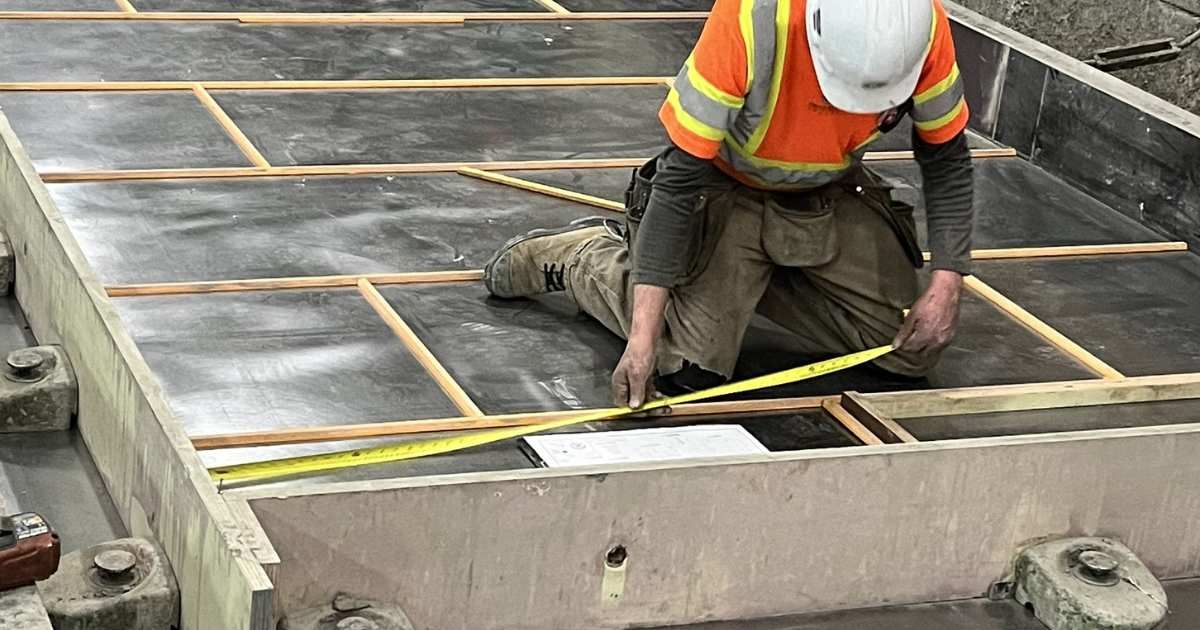
We talked a bit about Hollowcore slabs earlier. For this product, the concrete is not poured into a mold but rather extruded onto a casting bed. A specialized extruder machine moves along the bed, depositing a continuous layer of concrete while simultaneously forming the hollow cores.
The top surface of the extruded slab is automatically leveled and smoothed by the extruder. Any additional finishing can then be done manually or with automated tools.
After the concrete has been poured and finished, it enters the curing phase—the step that allows the concrete to gain strength and harden over time.
During curing, a chemical reaction called hydration occurs, where the cement reacts with water to form a strong, durable matrix that binds the aggregates together.
Curing is a temperature-sensitive process, and maintaining optimal temperatures is crucial for achieving the desired concrete properties.
Low temperatures can slow down the hydration process and delay strength development. Precast plants often use heating systems to keep the curing area warm during colder months.
High temperatures can cause the concrete to dry too quickly, leading to cracking and reduced strength. In warmer weather, cooling systems may be used to prevent excessive heat buildup.
Precast plants in regions with varying climates, like ours in Ontario, are careful to regulate the temperature in the plant throughout the year.
After the initial curing period, the precast products are typically moved to a designated curing area, where they continue to harden under controlled conditions for several days or weeks. The curing time and temperature are carefully monitored and adjusted based on the specific mix design and desired strength properties of the concrete.
Once the precast concrete has reached its specified strength, the next stage involves carefully separating them from the molds or casting beds. This is a careful process that requires skilled handling to avoid any damage to the finished product.
For precast products cast in molds, the forms are gently removed. This is typically done by loosening the side panels or using hydraulic systems to carefully separate the mold from the concrete.
For continuous pieces like Hollowcore slabs, the process differs. The slab is first cut into individual sections using a specialized saw. These sections are then lifted off the casting bed.
Overhead cranes are the most common method for lifting and moving precast, especially larger ones. These cranes are equipped with hooks or specialized attachments to securely grip and transport the product.
Before being stored or transported, each precast product undergoes a thorough quality control process:
Every piece is visually inspected for any imperfections, such as cracks, chips, or surface inconsistencies.
Depending on the product and its intended use, additional tests might be conducted. This could include load testing to assess structural integrity or other specialized tests based on the project requirements.
Precast plants usually have designated storage yards where finished products are organized and stored until delivery.
Deliveries are carefully coordinated with the construction site to ensure that the products arrive on time and in the correct order for installation.

While the machinery involved in precast concrete manufacturing is impressive and all, we’d be remiss not to mention the essential role played by skilled workers.
There’s a lot of physically demanding, hands-on work that goes into making concrete. Manufacturing precast concrete to a high-quality standard requires a solid understanding of the materials, engineering principles, and processes that we’ve barely scratched the surface of here.
From formulating the perfect concrete mix (both an art and a science), to reading technical drawings, to operating complex machinery, every step relies on the skill and experience of trained professionals.
At Fritz-Alder Precast, we take pride in our team's well-rounded skills and experience. We have experts in mix design who understand the intricate science of concrete, while others specialize in rebar, formwork, and more. And our quality control inspectors carefully examine every precast element, and our operators are highly proficient at running the sophisticated machinery on our factory floor.
It's this combination of technical know-how, experience, and commitment that allows us to consistently deliver high-quality precast products that meet and exceed industry standards.
Interested in learning how precast concrete can make a difference in your next project? Reach out to us for a detailed discussion and a personalized quote.
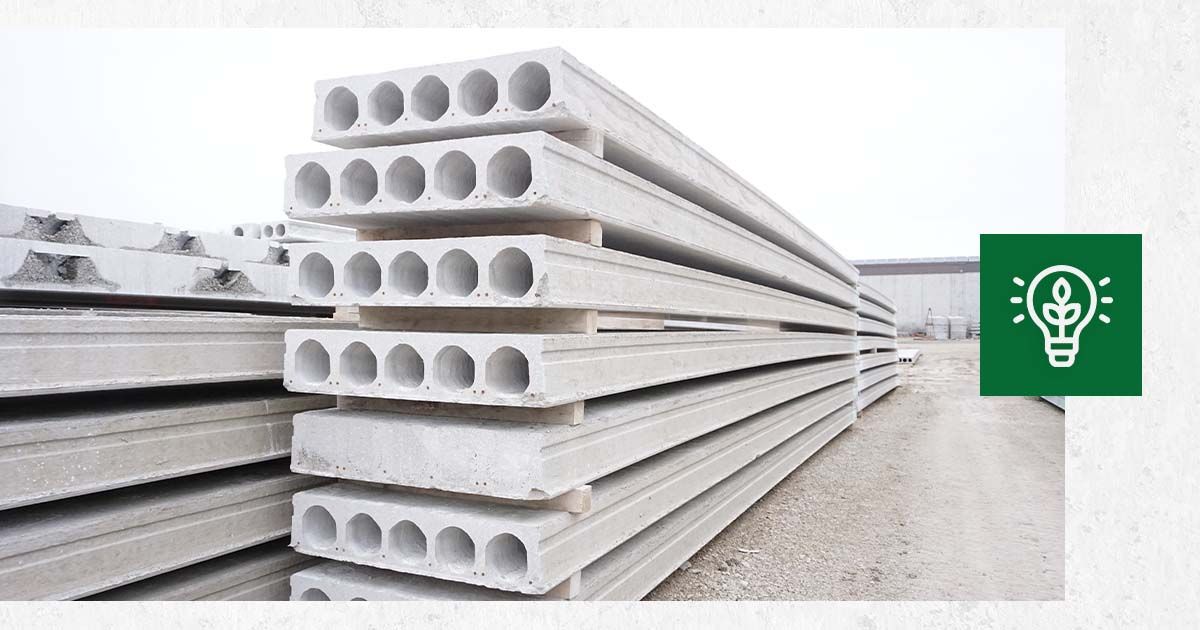
When you think about sustainability, concrete might not immediately spring to mind. It's hard, it’s heavy, it doesn’t grow on trees, and, well, it's pretty much here to stay once it's set.
But hold that thought. There’s a lot about concrete, especially precast, that most people don’t know. In fact, given the needs of modern infrastructure and improvements in manufacturing, precast makes a lot of sense when it comes to sustainability in construction.
How? Let’s get into it. In this post, we’re digging into the ways that precast concrete is paving the way for a more sustainable future.
Fritz-Alder Precast is at the forefront of precast concrete. Our commitment to quality, craftsmanship, and sustainability has earned us a reputation as an industry leader. Get in touch with our team to discuss your project requirements.
Climate change, resource depletion, and environmental degradation are real threats, and construction is one of the largest contributors to carbon emissions. And with cities like Toronto aiming for zero emissions in new construction by 2030, we need to look at materials and methods that are more environmentally responsible.
One material that ticks all the right boxes is precast concrete. Yes, concrete, the most abundant building material we have.
At first glance, concrete might not seem like the poster child for sustainability. Its production is energy-intensive, and it's everywhere in our urban landscapes. But when you take a closer look, things look quite different.
The precast process, from factory to site, is marked by steps that conserve resources, reduce emissions, and promote efficiency, making it a sustainable choice for today’s construction projects.
Here, we’re going to zero-in on the manufacturing, transportation, water use, and durability benefits that give precast a sustainable edge.
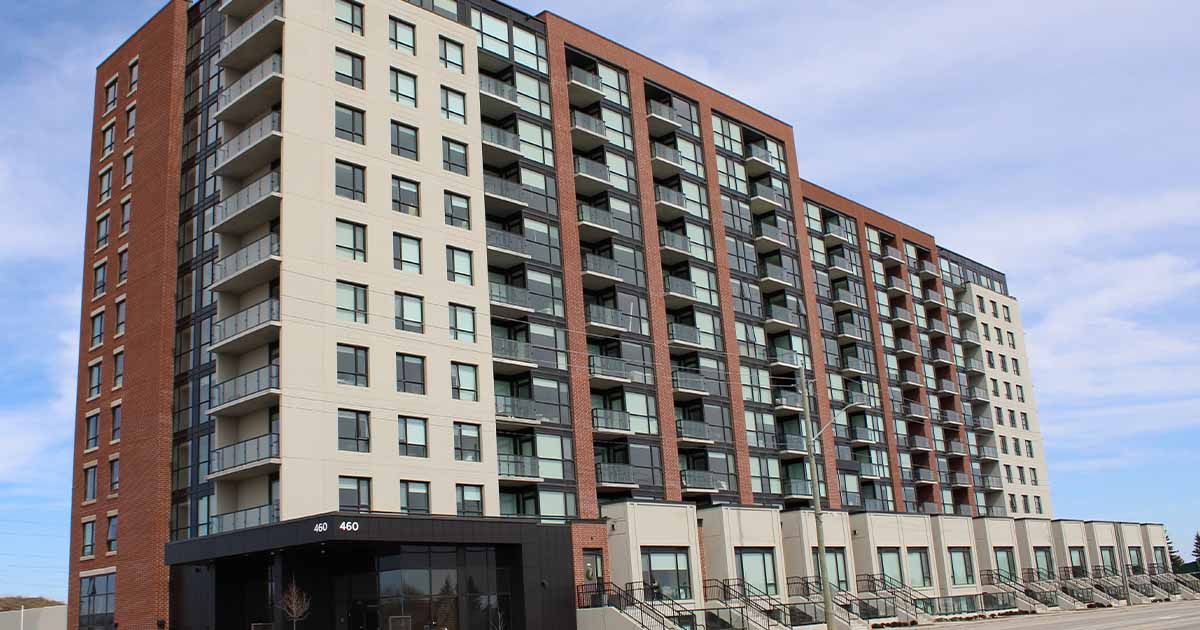
What makes durability so important for sustainability? It’s simple.
The longer a building lasts without needing major repairs or replacement, the less material we need to use over time. This means fewer resources extracted from our planet, less energy spent on manufacturing new materials, and, importantly, less waste ending up in landfills.
When you build with precast concrete, you’re building something that can last not just a few decades, but centuries or more.
Better yet, when we finally reach the end of a structure's life (be it 50 years or 200 years from now), precast concrete can give one final nod to sustainability. Concrete can be recycled and reused in the form of recovered aggregate, finding new life in other projects as a base material or engineered backfill.
When we choose materials that are built to last, we're not just investing in our immediate future but in a sustainable world for generations to come.
Unlike concrete that's mixed and poured on-site, precast concrete is manufactured in a controlled factory environment. This process might seem minor in difference but is major in impact.
In the controlled environment of a factory, every mix is measured with care, ensuring not a drop of water or pinch of cement goes to waste. This precision cuts down on excess materials, slashing the waste that's all too common in on-site pours.
Pouring in a factory also means that conditions are always ideal for concrete production. There's no waiting for the right weather to pour or cure concrete. This not only speeds up the construction process but also makes it far more. Less energy used means a smaller carbon footprint, a win for any project aiming to be green.
Precasters have another trick up their sleeve: recycling. Almost everything that can be reused is. Steel and fiberglass forms are reused time and again, and plywood forms can be dismantled and reused, reducing waste and minimizing the need for new resources.
The entire operation runs on a waste not, want not mindset.
In a world where every drop counts, it is important to think about how we can reduce how much water we use in construction. Concrete is known to be a huge water guzzler. But this is another area where precast comes in clutch.
Precasters use just what they need, no more, no less. Every stage of production is as efficient as possible, and that includes how much water we use.
Since precast concrete is made off-site and delivered ready to install, the need for water on the actual construction site is dramatically reduced. There’s no mixing, pouring, or curing with additional water on-site. This means your overall project has a smaller water footprint.
Another way precast concrete contributes to sustainability is by reducing transportation emissions. This might seem a bit contradictory at first—after all, concrete is heavy, and moving heavy things usually means burning a lot of fuel. But the story changes when we consider the local nature of precast concrete production and use.
Many of the materials used in precast concrete manufacturing, like sand, gravel, and stone, come from local sources. We’re not shipping it from overseas. Since our materials don't have to travel far to get to our factory, transportation emissions are minimized. It's a straightforward journey from quarry to factory to construction site.
Here in Ontario, where natural resources are plentiful, this local loop of production and supply means trucks spend less time on the road. Fewer miles driven equals less fuel consumed and fewer emissions released into our atmosphere. It’s a great example of how thinking locally can have a big impact on reducing our carbon footprint.
Plus, precast concrete components are made to measure and ready to install upon arrival at the construction site. This efficiency not only speeds up the building process but also means fewer trips back and forth. It’s a major improvement over the constant back-and-forth of cement trucks to pour concrete on site.
Like any construction material, precast concrete faces its share of sustainability challenges. From the energy-intensive process of creating cement to water use, our industry is under pressure to find solutions that are more in line with our broader environmental goals.
The good news is that precasters are problem-solvers by nature, whether it’s solving design challenges by designing and building new forms or coming up with sustainable solutions.
One major hurdle is the carbon footprint associated with producing cement. Cement production is a major source of CO2 emissions. However, the industry is not standing still.
There's a growing shift towards alternative cementitious materials (ACMs) such as fly ash, slag, and silica fume, often by-products of other industrial processes, to lower the emissions involved with making cement.
Energy consumption is another area where precast concrete aims to improve. As manufacturing technology advances, our processes are becoming more energy efficient. From optimizing the curing process to implementing better insulation and energy recovery systems in factories, precasters are quickly finding ways to slash the overall energy footprint of precast concrete production.
Over the past three decades, the Canadian cement and concrete industry has improved manufacturing efficiency by 20%, with an ambitious milestone to reduce the carbon intensity of cement by up to 40% by 2030.
We’re also seeing companies pioneering technologies to capture CO2 emissions from cement production and use them to cure concrete. This technology is still new, but it’s likely to move in leaps and bounds as more R&D is put towards sustainable precast concrete.
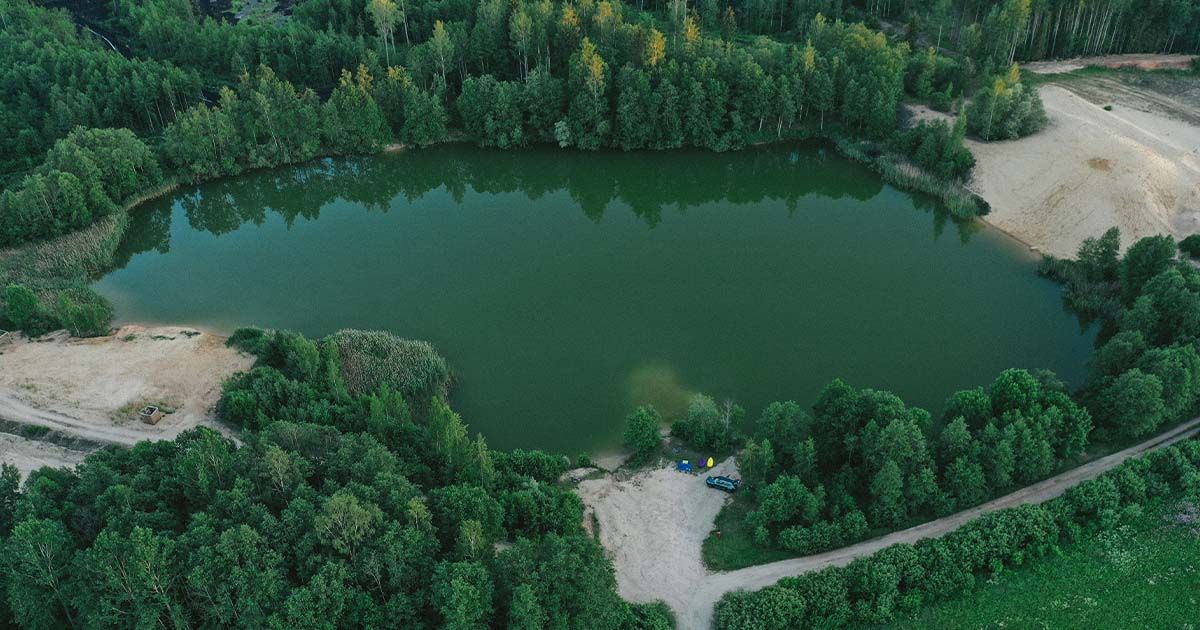
Quarries are necessary for extracting the sand, gravel, and stone that form the foundation of our concrete structures. But, as we dig deeper into the earth to meet our construction needs, we face the dilemma of environmental impact versus material necessity. It's a tough balance, but one that we're learning to manage more sustainably.
The good news is that the industry is stepping up. The Aggregate Resources Act (ARA) in Ontario mandates that quarry sites be rehabilitated, and there are numerous examples of successful quarry rehabilitation projects.
One standout example is the Kelso Quarry, near Milton, Ontario, which has been transformed into a vibrant community resource featuring new wetlands, extensive tree planting, and a constructed lake that is now a healthy fish habitat.
Fritz-Alder Precast is committed to advancing sustainable precast construction practices. Interested in learning how sustainable precast concrete can make a difference in your next project? Reach out to us for a detailed discussion and a personalized quote.
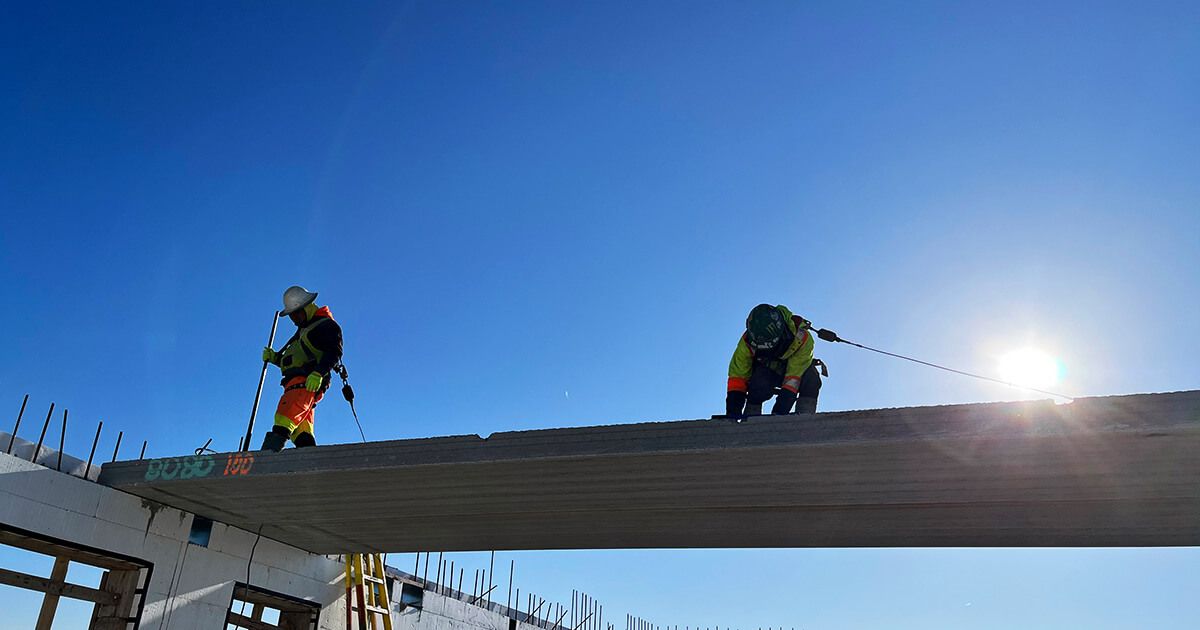
Explore how precast concrete and Hollowcore slabs are revolutionizing large-scale construction with efficient, sustainable solutions.
In large-scale construction projects, choosing the right type of flooring system is an important decision.
It's not just about using materials that withstand the test of time, but also choosing a system that makes sense for your project's timelines, budget, and practical needs.
This is where Hollowcore precast slabs stand out. Hollowcore slabs are special because they combine everything you want in a floor system: structural strength, installation efficiency, and sustainability. They're not new, but how we make and use them today shows how far we've come in building better, faster, and smarter.
Hollowcore slabs are made for today's building challenges, cutting down on construction time and costs without cutting corners on quality. Let’s look at how Hollowcore slabs are revolutionizing flooring systems in large-scale projects.
Fritz-Alder Precast is at the forefront of precast concrete, including the largest selection of Hollowcore thickness and spans on the market. Get in touch with our team to discuss your project requirements.
Hollowcore precast slabs are a type of precast product used to construct floors and roofs in many types of buildings. They have cylindrical holes or 'voids' running the entire length, making them lighter but equally strong as solid concrete slabs of the same thickness. The size and number of voids can vary depending on the specific load requirements of the project.
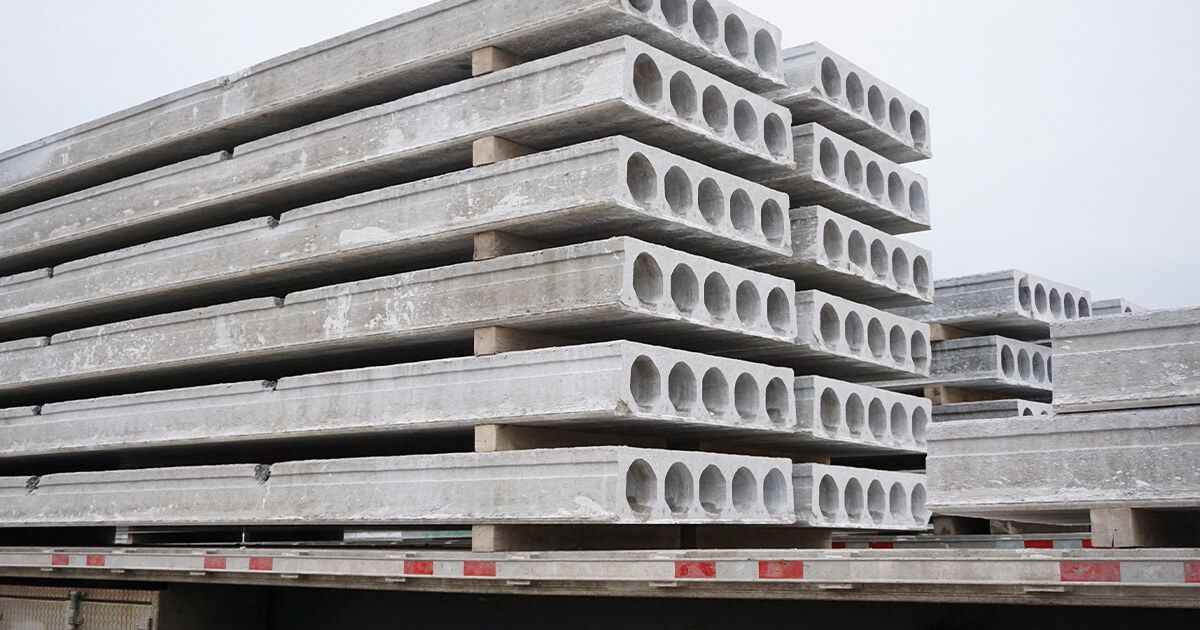
The idea behind Hollowcore slabs is not new. It dates to the early 20th century when manufacturers searched for ways to reduce the weight of concrete slabs without sacrificing strength. These efforts led to the development of Hollowcore slabs as we know them today.
Over the years, these slabs' production methods and technology have evolved, making them even more efficient and versatile for modern construction needs.
The combination of hollow design and prestressing gives Hollowcore slabs their main advantages: they are lighter, which can reduce costs related to materials and transportation, and they are very strong, capable of spanning long distances without support. This makes them an ideal choice for large-scale projects, such as commercial buildings, parking garages, and residential complexes.
As technology has advanced, so can produce Hollowcore slabs that meet the specific needs of modern construction projects. For example, the industry used to rely on vibrating extruders. While effective for compacting the concrete and creating the slabs, the constant vibration could lead to inconsistent quality. Today, Fritz-Alder Precast uses shear compaction extruders, which results in a denser slab with more precise dimensions and fewer defects.
Plus, because the process is more reliable, we can produce slabs faster and more efficiently and pass on the benefits of reduced waste and lower costs to our customers.
Hollowcore slabs are prestressed, meaning the concrete is pre-compressed during manufacturing to better handle tensile forces once in use. This process involves stretching steel strands before pouring the concrete and releasing the tension once the concrete has cured, compressing the concrete and making it stronger.
A helpful analogy for understanding how prestressed concrete works is this:
Just like the rubber band keeps the cards tightly together, allowing you to move them as one solid block, the prestressed steel keeps the concrete compressed, enhancing its structural integrity and enabling it to support heavier loads without cracking.
When we compare Hollowcore slabs to traditional flooring systems such as cast-in-place concrete, steel deck, and wood framing, four key benefits stand out: strength, cost and material efficiency, installation time, and environmental impact.
When we compare Hollowcore slabs to traditional flooring systems, five key benefits stand out: strength, cost and material efficiency, installation time, environmental impact, and design efficiency.
Hollowcore slabs are designed to provide long spans without the need for intermediate support, which opens a range of possibilities for architects and engineers designing large spaces.
The ability to span large distances is due to the strength of the prestressed concrete and the unique hollow design, which reduces the slab's weight while maintaining its structural integrity.
One key benefit of using Hollowcore slabs is the reduction in overall weight. The presence of voids within the slab means that less concrete is used, making the slab lighter than a solid concrete floor of the same thickness. This lighter weight reduces the load on the building's foundation and other structural elements, which can save materials and construction costs.
Additionally, the reduced weight makes the slabs easier to transport and handle on-site, speeding up the construction process.
Hollowcore slabs are recognized for their role in reducing construction costs, a benefit that comes from material savings, lower transportation costs, and reduced labour needs.
First, the material savings stem from the slab design itself. The hollow cores mean less concrete is used to achieve the same if not superior, strength and durability as a solid slab. This material reduction lowers the cost of the concrete used in the slabs and contributes to a lighter structure. A lighter structure can mean a foundation that requires less material, further reducing costs.
Hollowcore slabs also have lower transportation costs. Their lighter weight makes them easier and cheaper to transport compared to solid precast concrete slabs. This is especially beneficial for large-scale projects with huge amounts of materials.
Finally, Hollowcore slabs are precast, meaning they arrive on-site ready to install, which eliminates the need for extensive formwork and curing time associated with pouring concrete on-site. As a result, the floor can be completed much faster, decreasing the amount of time workers must spend on site.
We just mentioned that Hollowcore slabs are manufactured off-site in a controlled environment and arrive at the construction site ready to install, which cuts out the many time-consuming steps associated with cast-in-place concrete. But that's not the only way Hollowcore slabs help you meet construction deadlines.
Hollowcore slabs are straightforward to install. Since they are manufactured off-site to exact specifications, each slab fits into place like a puzzle piece. This precision reduces the need to make on-site adjustments and modifications, allowing you to move faster from one construction phase to the next.
Plus, as mentioned earlier, Hollowcore slabs can be prestressed to increase their strength and durability. This means they're ready to bear loads immediately after installation. Hollowcore slabs create an instant work platform for other trades to begin work like electrical and plumbing installations, speeding up the overall construction process.
Another aspect of speed comes from the ability of Hollowcore slabs to serve as an immediate work platform once installed. This means subsequent construction activities, such as electrical and plumbing installations, can commence sooner, further accelerating the overall construction timeline.
Hollowcore slabs also for their sustainability and lower environmental impact relative to other flooring systems.
For one, these slabs use less material than traditional solid concrete floors thanks to their hollow design. This reduction in material not only lowers the cost of resources but also decreases the cost of transportation and gives buildings a smaller overall carbon footprint.
Hollowcore slabs can also benefit the environment by incorporating recycled materials. The concrete used in these slabs often includes recycled aggregates or supplementary cementitious materials, such as fly ash or slag cement.
Plus, the manufacturing process of Hollowcore slabs is highly efficient, producing less waste compared to traditional on-site concrete pouring methods. Since the slabs are precast in a controlled factory setting, there's better management of materials and minimal excess concrete. This efficiency contributes to a reduction in construction waste, aligning with sustainable building practices.
Another big advantage of Hollowcore slabs is their design flexibility. These slabs can be cut to fit various building shapes and sizes, allowing for a high degree of customization in building design.
This adaptability is particularly useful in projects with unique architectural features or specific functional requirements. Architects are given more freedom—no need to design around bulky columns—and the cost savings mean that capital can be used on other features that enhance a building's value.
Additionally, the voids in Hollowcore slabs can serve as conduits for electrical wiring, plumbing, and HVAC systems, further enhancing their utility in building design.

Hollowcore slabs offer a solid advantage for large-scale construction projects. They're not only used to saving time and money, although they do that well. They also tick the box for being sustainable, using less material without skimping on strength.
Here at Fritz-Alder Precast, we're all about pushing the limits of what construction materials can do. Our Hollowcore slabs lead the pack with their mix of size, strength, and environmental benefits. Whether you're planning a towering high-rise or a sprawling complex, we've got the right slab for the job
For all your precast concrete solutions, consider choosing Fritz-Alder Precast. If you want to learn more about us and how we can help you with your next project, you can meet us in person or virtually to learn more about our products and services. We'll even provide lunch and give you the chance to learn.
Request a lunch and learn if you want to learn more about how we can help you.
